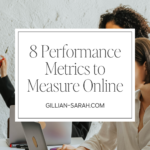
8 Performance Metrics to Measure Online
Table of Contents
ToggleSharing is caring!
Reading Time: 5 minutes


When you're growing a business online, you're pouring significant money and effort into promoting your business to attract customers. That's why executing a marketing campaign has to be done right. You need to choose the right strategies to achieve the best results.
How do you know if your marketing efforts are paying off?
If you've been promoting online, you probably come across the term “measuring the metrics,” but what does it mean?
In digital marketing, measuring the metrics involves careful and regular evaluation of a marketing strategy. The process includes making data-driven decisions and refining every marketing strategy according to analytics to attract customers and achieve a higher return on investment.
Now that you know how vital measuring the metrics is to the success of a marketing campaign, you might ask yourself: What metrics do I focus on? How do I collect these infos and apply the insights to my marketing campaign?
That's what this guide is all about. Continue reading below to find out what essential metrics to track if you're promoting a business online:

8 Performance Metrics to Measure Online
Impressions
Impressions refer to the number of times your content was shown or presented to potential or existing customers on a website or app. Checking the impressions lets you know the level of exposure a post has received. The technology to measure impressions isn't perfect because there's still no way to tell if the content was seen by an actual human.
Clicks: Clicks are the number of times people click on an ad that leads to your website. The link could be embedded in an email, social media shoutout, or Google Search and Display ads. Monitoring this metric gives you an idea how many viewers your marketing campaign has reached.
Clickthrough rates (CTRs): On the other hand, CTRs measure clicks in proportion to impressions. It gives you an idea of how engaged your customers are when viewing your promotional content. Clickthrough rates are influenced mainly by persuasive copywriting, attractive visuals, and excellent ad placement.
Conversions
This measures the number of people who have taken the desired action after viewing your marketing content. Tools like Google Analytics will help you determine and monitor your conversion goals. Examples of conversion indicators are signing up for newsletters, completing an online purchase, or booking an appointment. Monitoring the conversions paints a picture of your ROI and tracks your conversion goals.
As for tracking, there are two factors to consider: the conversion rate and cost per conversion. The conversion rate measures the number of conversions as the proportion of the clicks collected. By keeping track of this metric, you'll know if your calls to action are persuasive enough and avoid disconnection between customers and your copy, ads, or landing page
Cost per conversion, aka cost per lead, determines the average conversion costs. This metric helps define your best-performing campaigns and which ones are not giving you the best results. This way, you can improve your promotional campaign and eliminate ineffective strategies that only cost you money.
Website Traffic
Measuring your website traffic gives you an idea of how users interact with your website, how relevant your content is to a specific audience, and the overall effectiveness of your marketing campaign.
If your website generates high organic traffic consistently, there is a higher chance of making more sales. To learn critical insights about your website traffic, you must use web analytics tools like Google Analytics to fine-tune your marketing strategies and generate more traffic.
You can also combine social media marketing, email marketing, traditional SEO, and influencer marketing to promote your brand, expand your reach, and make a meaningful connection with industry leaders and potential customers.
Time on Site and Bounce Rates
Tracking the average time visitors spend on your website gives you an idea of how relevant your content is to users and if you're attracting the right audience. The more valuable and engaging the content is, the longer a user stays on your website.
Bounce rates measure the number of visitors who leave your website after a brief interaction. There are many reasons why visitors would immediately leave – your content might not be what they're looking for, the loading speeds could be too slow, or the channels these readers come from are inefficient.
You can offer guest checkout, choose a mobile-friendly website design, and develop a strong call to action to increase your conversion rate. Whatever the issue is, you need to figure it out to minimise your website's bounce rate.
Advertising Costs
If you've been using paid ads to promote your website online, you must determine if the marketing costs generate results. To calculate the advertising cost, use the formula: ROAS (return on ad spend) = revenue/advertising spend.
For example, if you are spending £500 on ads and your revenue is £1000, calculate the ROAS by dividing £1000 by £500 = 2 or 200%. Any number greater than one means the advertising cost generates more money inflow than outflow.
Do note that the formula may not apply all the time because the sale cycle length will vary. It might not provide accurate results, but it will give you an idea of how your promotional ads contribute to your bottom line.
Customer Acquisition Cost (CAC)
CAC measures the average spend of your business to convert a user into a paying customer for a specific period. To calculate the CAC, use the formula: CAC = Sales and marketing cost / Number of customers acquired,.
Your CAC depends on certain factors, such as sales potential and business strategy. The goal is to have clients spend more on your business than you're paying to get them.
For example, suppose you are conducting an email marketing campaign. In that case, you will invest in an automation tool, pay ads, acquire referrals, and promote on social media – most of these cost money to implement. If you are getting dismal results despite spending a significant portion on paid marketing services, you are not getting your money's worth.
If your marketing strategies barely generate results, you must re-target your ad campaigns and utilise free and paid channels to spread the word about your business and acquire referrals.
Customer Lifetime Value (CLV)
CLV measures the total value a paying customer brings into your business in a specific period. It is an estimation of a customer's lifespan.
CLV helps you learn key insights about a client's buying journey with your business. This helps sort out issues that can slow down the entire buying process. You can also make informed decisions about the money you want to spend on customer acquisition and develop an effective customer retention strategy.
To track CLV, use the formula: CLV = Average Customer Value x Average Customer Lifespan.
Although the exact value of a consumer's entire life span is difficult to calculate, you can track the purchase actions and habits of the customer to get an estimate on CLV.
Search Impression Share
Search Impression Share tracks the frequency at which your website appears on branded searches. A high search impression share requires well-researched, branded keywords. These keywords will boost visibility so more people can be led to your website. To measure the search impression share, you need to determine the percentage terms of the frequency at which your campaign shows up using your keywords. Use this formula for the calculation:
Search Impression Share = Impressions via a search network/number of total searches. If, for example, your search impression share is at 70%, it means your ad showed up 70 times out of 100.
To increase your brand's search impression share, try using precise keywords, improving the persuasiveness of the copy, and investing in paid ads and social media marketing.
Measuring the metrics is an essential step in building a successful brand. It optimises your marketing efforts by helping you make data-driven decisions. With this guide, you can perfect your marketing campaign and hit all your marketing and financial goals!
Most Popular Posts:
Sharing is caring!
PLEASE COMMENT BELOW